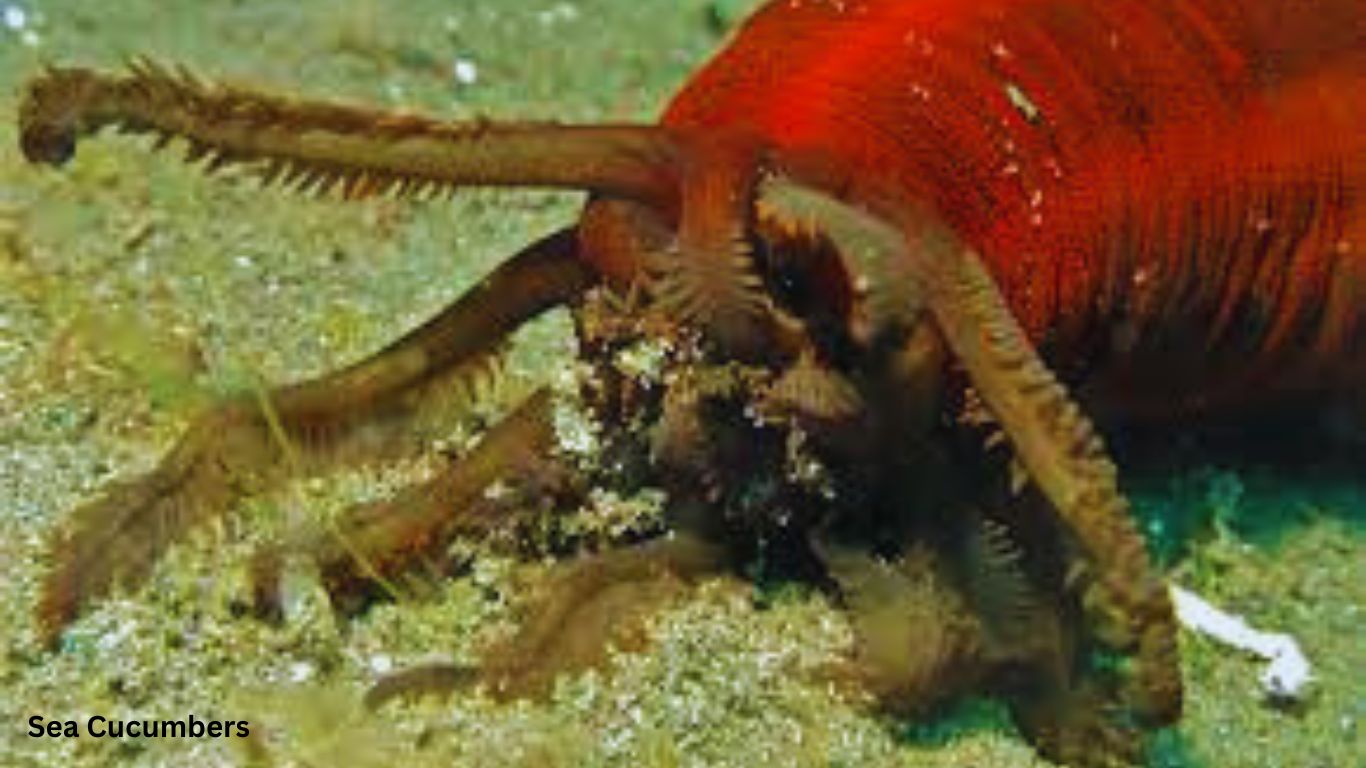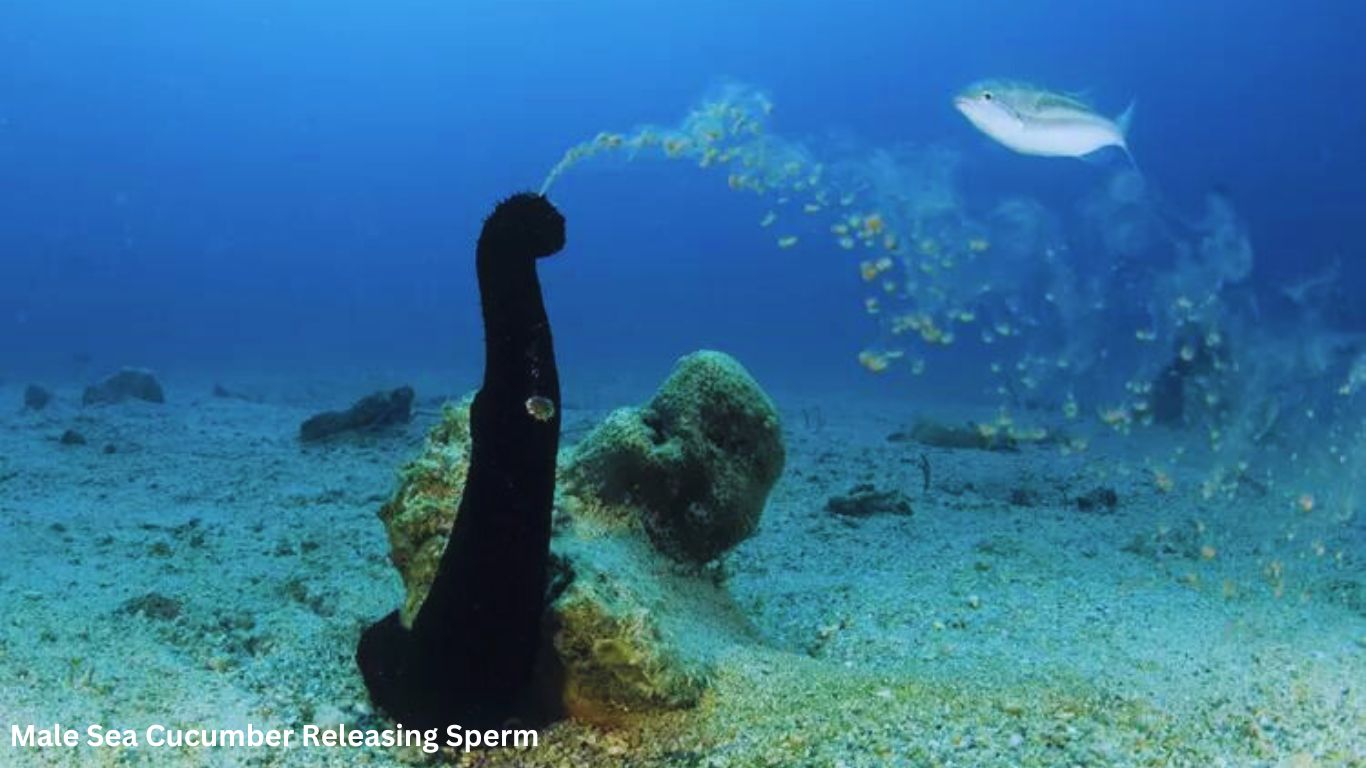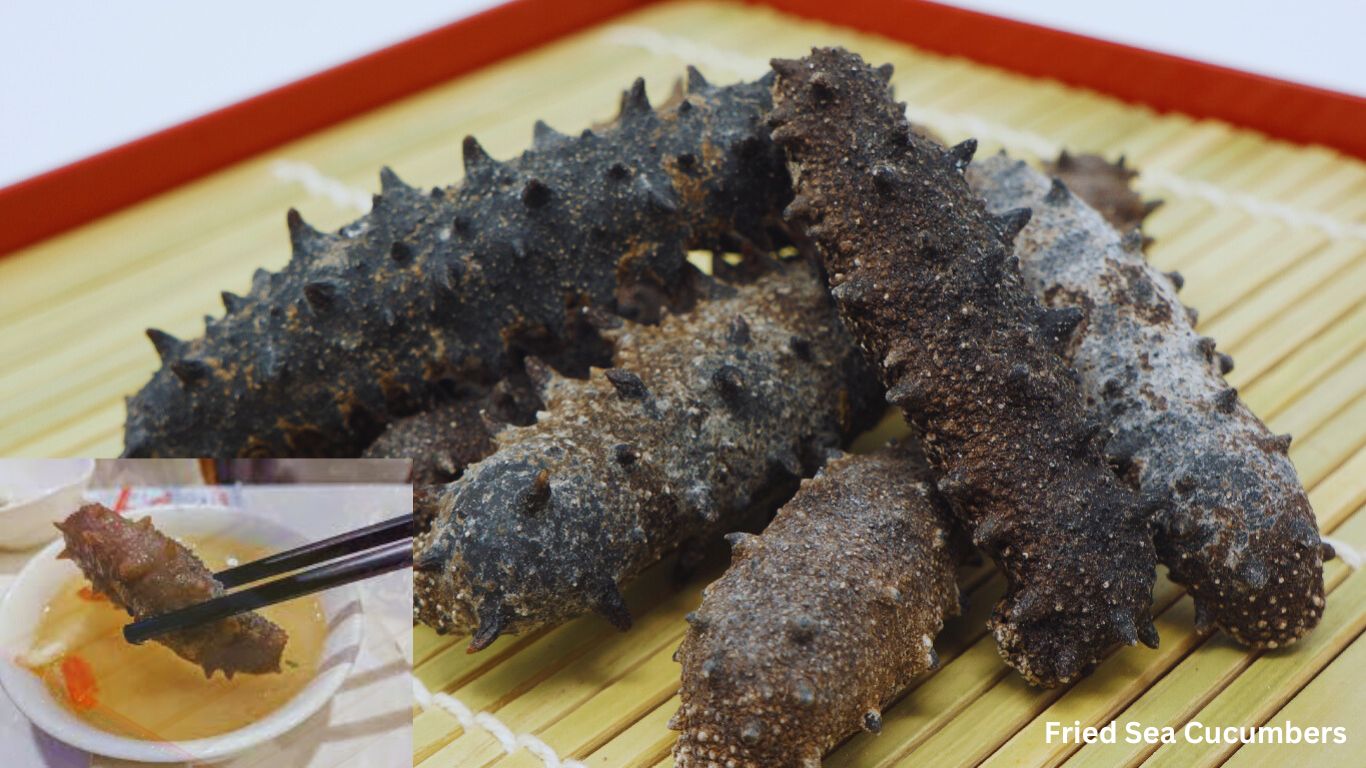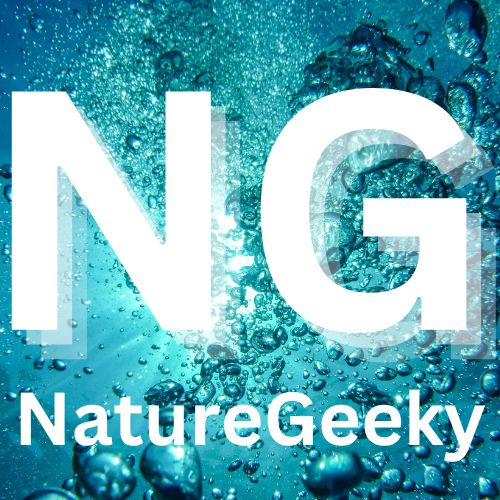10 Interesting Facts About Sea Cucumbers that one should know.
Sea cucumbers are marine animals that belong to the phylum Echinodermata, which also includes starfish and sea urchins.
1. Sea cucumbers are not dangerous to humans. They are docile and non-aggressive animals.
2. Sea cucumbers have a distinctive respiratory system that distinguishes them from other marine organisms, referred to as a respiratory tree.
3. Sea cucumbers have elongated bodies with a soft, cylindrical shape and a tough, leathery skin. They can range in size from a few centimeters to over a meter in length.
4. These fascinating creatures play an important role in marine ecosystems as detritivores, feeding on organic matter and helping to recycle nutrients.
5. Sea cucumbers have a unique defense mechanism called “evisceration.” When threatened, they can expel their internal organs, which can distract predators or even be toxic to them.
6. Some species of sea cucumbers have the ability to regenerate lost body parts, including their internal organs, which is a remarkable adaptation.
7. They are known for their interesting feeding habits, which involve using their tentacle-like structures called tube feet to sift through sediments or filter food particles from the water.
8. Sea cucumbers have been used in traditional Asian medicine for centuries. Certain species are believed to have various health benefits and are used to treat ailments such as joint pain and inflammation.
9. Humans also harvest sea cucumbers for culinary purposes. They are considered a delicacy in some cultures and are used in soups, stews, and other dishes.
10. Unfortunately, overfishing and habitat destruction pose significant threats to sea cucumber populations. Conservation efforts and sustainable harvesting practices are crucial to protect these unique and important marine creatures.

1. How do Sea Cucumbers Defend Themselves ?
Sea cucumbers have developed a variety of defense mechanisms to protect themselves from predators. Here are some notable defense mechanisms of sea cucumbers:
1. Evisceration: One of the most remarkable defense strategies of sea cucumbers is the ability to expel their internal organs, such as their digestive tract, through their anus. This process is known as evisceration. When threatened, sea cucumbers can contract their muscles and forcefully expel their viscera, distracting or deterring predators. They can later regenerate their lost organs.
2. Cuvierian Tubules: Some species of sea cucumbers have specialized structures called Cuvierian tubules. These tubules are elongated sticky threads found in the respiratory tree of the sea cucumber. When threatened, the sea cucumber can expel these tubules through its anus, entangling or immobilizing predators. The sticky threads can also secrete toxic chemicals, further deterring predators.
3. Toxic Chemicals: Certain sea cucumbers possess toxic chemicals or compounds in their body tissues. These toxins can be released as a defense mechanism to deter predators. The toxins may cause irritation, discomfort, or even poisoning in potential predators, making the sea cucumber an unattractive or dangerous prey.
4. Autotomy: Some sea cucumber species can intentionally detach or shed parts of their body, such as their tentacles or even sections of their body wall, as a defensive strategy. This can confuse or distract predators, allowing the sea cucumber to escape. The discarded body parts can later regenerate.
5. Camouflage: Sea cucumbers can also employ camouflage as a defense mechanism. Some species have the ability to change their skin color, texture, or pattern to blend in with their surrounding environment, making them less noticeable to predators. This adaptive camouflage helps them avoid detection and potential predation.
Overall, sea cucumbers have evolved a range of defense mechanisms, including evisceration, Cuvierian tubules, toxic chemicals, autotomy, and camouflage, to increase their chances of survival in the marine environment. These defense strategies showcase the incredible adaptability and survival mechanisms of sea cucumbers.
2. Regenerative Properties of Sea Cucumbers
Sea cucumbers are well-known for their impressive regenerative abilities. Here are some key points regarding the regenerative properties of sea cucumbers:
1. Regeneration of Body Parts: Sea cucumbers have the remarkable ability to regenerate lost or damaged body parts. They can regenerate various structures, including their intestines, tentacles, and even their entire body. This regrowth occurs through a process called morphallaxis, where existing cells rearrange and differentiate to form new tissues.
2. Speed of Regeneration: Sea cucumbers exhibit relatively rapid regeneration compared to many other animals. Some species can regrow lost body parts within a few weeks or months, depending on the size and complexity of the structure being regenerated.
3. Tissue Redifferentiation: During regeneration, sea cucumbers can redifferentiate existing cells to fulfill the functions of the lost or damaged tissue. This process involves the activation of specific genes and signaling pathways that control cell growth and specialization.
4. Regeneration after Evisceration: When sea cucumbers undergo evisceration (the expulsion of internal organs), they can regenerate their lost organs. After evisceration, the remaining tissues and cells initiate the regeneration process, allowing the sea cucumber to recover and restore its normal body functions.
5. Reproduction and Regeneration: Sea cucumbers can reproduce asexually through a process called fission, where the body splits into two or more parts that regenerate into new individuals. This ability enhances their regenerative potential and population growth.
6. Environmental Factors: Regeneration in sea cucumbers can be influenced by various environmental factors such as temperature, salinity, and food availability. Optimal conditions and a suitable environment can enhance the regenerative capacity of sea cucumbers.
The regenerative properties of sea cucumbers not only aid in their survival and recovery from injuries but also contribute to their population dynamics and ecological roles in marine ecosystems. Their ability to regenerate highlights their extraordinary regenerative potential and makes them fascinating subjects of scientific research.
3. Unique Respiratory System of Sea Cucumbers
Sea cucumbers possess a unique respiratory system that sets them apart from other marine organisms. Their respiratory system is known as a respiratory tree. Here are some key features of the respiratory system of sea cucumbers:
1. Respiratory Tree Structure: The respiratory tree of a sea cucumber consists of a branched network of tubules connected to the cloaca or anus. The tubules resemble the branches of a tree, hence the name “respiratory tree.”
2. Pumping Mechanism: Sea cucumbers have muscular contractions that enable them to pump seawater in and out of their respiratory trees. They draw water into the anus and push it through the tubules of the respiratory tree.
3. Gas Exchange: As seawater is pumped through the respiratory tree, gas exchange takes place. Oxygen in the water is absorbed into the respiratory tree, while carbon dioxide and other waste gases are expelled back into the water.
4. Modified Cloaca: The cloaca, which serves as the common opening for excretory, reproductive, and respiratory systems, plays a crucial role in the respiratory function of sea cucumbers. It functions as both an intake and an exhaust valve for seawater during the respiratory process.
5. Adaptation for Low Oxygen Environments: The respiratory tree of sea cucumbers allows them to extract oxygen from the surrounding water even in low oxygen environments. This adaptation enables them to survive in habitats where oxygen availability may be limited.
6. Waste Elimination: Besides its respiratory function, the respiratory tree also serves as a pathway for waste elimination. Undigested particles or waste materials expelled from the digestive system can be transported out of the sea cucumber’s body through the respiratory tree.
The unique respiratory system of sea cucumbers, with their specialized respiratory trees and pumping mechanism, enables them to obtain oxygen and eliminate waste efficiently in their marine environments. It is an adaptation that contributes to their survival and success in various ocean habitats.
4. Can You Eat Sea Cucumbers ?
Yes, sea cucumbers are edible and consumed in various cultures around the world. They are particularly popular in Asian cuisines, such as Chinese, Japanese, and Southeast Asian cuisines. In these cultures, sea cucumbers are often considered a delicacy and used in a variety of dishes.
Sea cucumbers can be prepared and cooked in various ways depending on regional culinary traditions. They are commonly used in soups, stews, stir-fries, braised dishes, and even as a filling in dumplings. The gelatinous texture of sea cucumbers makes them well-suited for slow cooking methods, allowing them to absorb flavors from the ingredients they are cooked with.
It’s worth noting that sea cucumbers are often sold in dried form, as they have a high water content that makes them prone to spoilage. Before consumption, dried sea cucumbers need to be rehydrated by soaking them in water for a period of time. This rehydration process softens the texture and prepares them for cooking.
In addition to their culinary uses, sea cucumbers are also used in traditional medicine in certain cultures, believed to possess various health benefits. However, it’s important to consult with experts and follow proper preparation methods when using sea cucumbers for consumption or medicinal purposes.
As with any food, personal preferences and tastes may vary, and some individuals may find the texture or flavor of sea cucumbers less appealing.
5. What Eats Sea Cucumbers ?
Several marine animals feed on sea cucumbers as part of their diet. Predation on sea cucumbers helps maintain a balance in marine ecosystems. Here are some of the common predators of sea cucumbers:
1. Fish: Various species of fish, such as groupers, triggerfish, and pufferfish, are known to prey on sea cucumbers. These fish may feed on sea cucumbers whole or target specific body parts, depending on their feeding habits and the species of sea cucumber.
2. Crustaceans: Certain crustaceans, including crabs and lobsters, are known to consume sea cucumbers. They can use their strong claws to break open the body wall of the sea cucumber and extract its tissues.
3. Sea Stars: Some species of sea stars, also known as starfish, feed on sea cucumbers. Sea stars have the ability to evert their stomachs and digest the tissues of the sea cucumber externally.
4. Sea Urchins: In some cases, sea urchins may graze on sea cucumbers, especially if they are in close proximity and there is limited food availability. However, predation by sea urchins on sea cucumbers is not as common as the other predators mentioned.
5. Sea Turtles: Certain species of sea turtles, such as green turtles, have been observed feeding on sea cucumbers. Sea turtles may crush or tear apart sea cucumbers with their strong jaws.
6. Marine Mammals: Some marine mammals, including certain species of seals and sea otters, have been known to consume sea cucumbers. They may forage for sea cucumbers in their habitats and feed on them as part of their diet.
It’s worth noting that the specific predators of sea cucumbers can vary depending on the region and the species of sea cucumber present. Predation on sea cucumbers is a natural part of the marine food chain and helps regulate their populations.
6. How Do Sea Cucumbers Eat ?
Sea cucumbers have a unique feeding method that allows them to consume organic matter and detritus from the surrounding environment. Here’s an overview of how sea cucumbers eat:

1. Tentacle Feeding: Sea cucumbers have specialized tentacles surrounding their mouth, called oral tentacles or oral papillae. These tentacles are typically arranged in a circle and are equipped with sensory cells that help detect food particles.
2. Filter Feeding or Deposit Feeding: Most sea cucumbers are either filter feeders or deposit feeders, depending on their feeding strategy.
a) Filter Feeding: Some species of sea cucumbers have evolved a filter feeding mechanism. They extend their tentacles into the water column, capturing suspended organic particles such as plankton or small food particles. The mucus covering the tentacles helps trap the food, which is then transported to the mouth.
b) Deposit Feeding: Other species of sea cucumbers are deposit feeders. They use their tentacles to sift through sediment and detritus on the ocean floor, extracting organic matter and microorganisms. They ingest the sediment and extract nutrients from the organic material while expelling the indigestible waste.
3. Pharynx and Digestive System: Once food is captured by the tentacles and transported to the mouth, it enters a muscular tube called the pharynx. The pharynx expands and contracts, grinding the food particles and breaking them down into smaller pieces. From the pharynx, the food moves into the digestive system of the sea cucumber, where further digestion and absorption of nutrients take place.
4. Waste Elimination: As sea cucumbers feed, indigestible particles and waste materials are expelled from their bodies through the anus, which is typically located on the opposite end from the mouth.
Sea cucumbers play a crucial role in marine ecosystems as detritivores, contributing to the recycling of nutrients and maintaining a balance in the marine food chain. Their feeding behavior helps process organic matter and recycle nutrients back into the ecosystem.
7. Reproduction and Life Cycle of Sea Cucumbers
A. Sexual Reproduction:
1. Most sea cucumbers reproduce sexually.
2. They have separate sexes, with individuals being either male or female.
3. Fertilization occurs externally, typically in the water column.
4. Males release sperm into the water, which is then captured by females through specialized structures.
5. Once fertilization occurs, the eggs develop into larvae.

B. Asexual Reproduction:
1. Some sea cucumber species can also reproduce asexually.
2. A common method of asexual reproduction is fission, where the body of the sea cucumber splits into two or more parts, each of which regenerates into a new individual.
3. Asexual reproduction allows sea cucumbers to rapidly increase their population size under favorable conditions.
C. Larval Development:
1. After fertilization, sea cucumbers go through a larval stage called a planktotrophic larva.
2. The planktotrophic larva is free-swimming and feeds on plankton in the water column.
3. The larval stage can last from a few days to several weeks, depending on the species.
4. During this stage, the larvae undergo various developmental changes, including the growth of body structures and the formation of characteristic features.
D. Metamorphosis:
1. After the larval stage, sea cucumbers undergo metamorphosis, where they transform into the benthic, bottom-dwelling adult form.
2. Metamorphosis involves significant changes in body structure, including the development of tube feet and the reorganization of internal organs.
3. The exact process and duration of metamorphosis can vary among different species.
E. Growth and Maturation:
1. Once the sea cucumber reaches its adult form, it continues to grow and mature.
2. Growth rates can vary depending on environmental conditions and food availability.
3. The time taken for sea cucumbers to reach sexual maturity can range from several months to several years, depending on the species.
Understanding the reproductive processes and life cycle of sea cucumbers is crucial for studying their population dynamics, ecological roles, and conservation strategies. It also highlights the diversity of reproductive strategies within this fascinating group of marine animals.
8. What Do Sea Cucumbers Taste Like ?
The taste of sea cucumbers can vary depending on the species and how they are prepared. Different cultures have different culinary traditions and methods of cooking sea cucumbers. Here are some general characteristics of the taste of sea cucumbers:

1. Mild Flavor: Sea cucumbers typically have a mild flavor that is often described as slightly sweet or briny. The taste is not usually overpowering or strongly pronounced.
2. Gelatinous Texture: Sea cucumbers have a unique gelatinous texture that can be somewhat chewy and slightly crunchy. The texture can vary depending on how they are cooked and prepared.
3. Absorbing Flavors: Sea cucumbers have a tendency to absorb the flavors of the ingredients they are cooked with. They are often cooked in savory sauces or soups that infuse them with additional flavors.
4. Umami Notes: Some people describe the taste of sea cucumbers as having umami notes, which is a savory and meaty taste often associated with seafood.
It’s important to note that the taste of sea cucumbers can be an acquired taste and may vary from person to person. The culinary preparation and seasoning play a significant role in determining the overall flavor and enjoyment of sea cucumbers as a food item.
9. Are Sea Cucumbers Dangerous ?
Sea cucumbers are generally not dangerous to humans. They are docile and non-aggressive animals. However, there are a few considerations to keep in mind:
1. Toxin Potential: Some species of sea cucumbers have toxins in their tissues as a defense mechanism against predators. These toxins can be harmful or even lethal to certain animals or humans if ingested or if there is direct contact with the toxins. It’s important to note that not all sea cucumber species possess toxins, and those that do may vary in the potency and effects of their toxins.
2. Skin Irritation: Handling certain species of sea cucumbers with bare hands can cause skin irritation or allergic reactions in some individuals. This is more likely to occur if the sea cucumber’s skin is damaged or if there is contact with its body fluids.
3. Spiky or Sharp Projections: Some sea cucumber species have spiky or sharp projections on their skin, which can cause puncture wounds if handled carelessly. It is advisable to handle sea cucumbers with caution and, if necessary, use protective gloves or tools to avoid injury.
4. Contamination: Sea cucumbers, like any other marine organism, can accumulate pollutants or toxins from their environment. If harvested from polluted waters or consumed without proper processing and cooking, there is a risk of contamination that could be harmful to human health.
It’s important to exercise caution and follow proper handling, cooking, and preparation techniques when dealing with sea cucumbers. If you encounter sea cucumbers in their natural habitat, it’s generally best to observe them from a distance and avoid touching or disturbing them to ensure their well-being and your safety.
10. Why do sea cucumbers eat sand?
Sea cucumbers are known to ingest sand or sediment as part of their feeding behavior. While it may seem unusual, there are several reasons why sea cucumbers consume sand:
1. Extraction of Organic Matter: Sea cucumbers are often deposit feeders, meaning they extract organic particles and detritus from sediment. By ingesting sand along with the organic-rich sediment, they can extract and digest the organic matter contained within it.
2. Nutrient Acquisition: Sand can contain organic materials, such as decaying plant and animal matter, as well as microorganisms. Sea cucumbers consume sand to access these nutrient-rich components, extracting essential nutrients from the organic content of the sediment.
3. Digestive Processes: Some species of sea cucumbers have specialized structures in their digestive system that aid in the breakdown and digestion of sediment particles. Sand ingestion helps facilitate the movement of food through their digestive tract and assists in grinding and breaking down the ingested material.
4. Sediment Stabilization: In certain cases, sea cucumbers consume sand to aid in sediment stabilization. By processing and redistributing sediment particles through their feeding activities, they can contribute to maintaining the stability of the seabed and preventing sediment erosion.
It’s important to note that not all sea cucumbers consume sand, and their feeding behavior can vary depending on the species and their ecological niche. Additionally, the specific reasons for sand ingestion may differ among sea cucumber species. Nevertheless, sand consumption by sea cucumbers serves various ecological functions, including nutrient acquisition, sediment processing, and ecosystem stability.
Some Reference Sites

